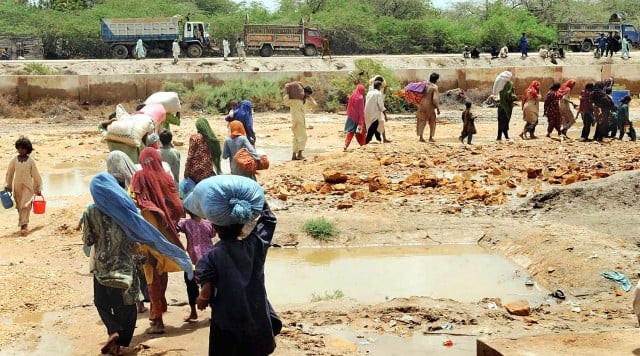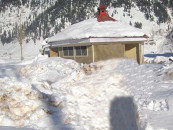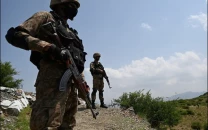As Phet moves on, so do the evacuees

According to the director of the Provincial Disaster Management Authority, Sualeh Ahmad Farooqi, the nearly 70,000 people that had evacuated their homes in fear of Cyclone Phet have all begun moving back with the passing of the storm. Almost 33,000 residents of Baba, Bhit, Manora and Shams islands have started vacating the relief camps.
Similarly, more than 5,000 people relocated in Badin are moving back home on vehicles provided by the district administrators. There were 15 relief camps set up for the people of Ahmad Raju, Serani, Bagra Memon, Golarchi and Kadhan.
Survey to estimate losses to be held
A survey will be conducted to find out how much damage was caused by Cyclone Phet as it bypassed Karachi and hit further east on the Sindh coast at Bhambor, said Farooqi. In this regard, district administrations have been directed to work out estimates of the loss of lives and property in the wake of the storm.
The DCOs of Karachi, Hyderabad, Thatta and Badin have visited the affected areas and will forward their reports to the Sindh Chief Minister.
Meanwhile, three people were injured when a roof collapsed in Kunri, District Umerkot. Sita, 35, and her six-year-old daughter, Anjali, were in the room when the roof collapsed and the man who came to their rescue was also injured. They were taken to the district hospital. Sita’s husband said that he requested the TMO to repair their roof but no one came to their help.
Three people were electrocuted in Tando Haider, Hala Naka and Naseemnagar. The deceased were identified as Abdullah, Ajmal and Ayub Shaikh. A number of houses in squatter settlements were damaged as a result of rain.
Out of the 78 feeders installed to supply electricity to Hyderabad, 35 developed faults while power supply from the remaining feeders was suspended, said chief engineer operations Hyderabad Electric Supply Company Musa Mirbahar.
Several officials have also visited the affected areas in Hyderabad, including Sindh Health Minister Dr Sagheer Ahmad, Shakir Ali and members of Muttahida Qaumi Movement’s Rabita Committee.
Eighty per cent of the water has been drained out of Hyderabad through generators, said Dr Ahmad, adding that rain water had entered houses in Latifabad, Qasimabad, Tando Thoro and Mazar Para. Provincial Minister for Fisheries also visited Qasimabad, in Hyderabad and said that the Hyderabad Electric Supply Company is responsible for flooding on the roads.
Karachi copes with post-rain syndrome
Life has returned to normalcy for the people of Karachi after torrential rains hit the city. Offices were open and several roads were cleared for traffic.
The worst affected areas included Orangi Town, Saddar, Mahmoodabad, Punjab Colony, Pak Colony, Golimar, Manzoor Colony, Rehri Goth and Kala Pul.
Despite the warnings issued by the Met office, houses in low-lying areas were flooded; in fact, even the CM House was not spared.
Jinnah Postgraduate Medical Centre was also flooded creating problems for its staff as well as patients. Rain water entered the nursing hostel and the emergency and other wards in the hospital. There were leakages in the roofs of several wards and the authorities failed to drain it even a day after the heavy rainfall.
Rain water has still not been drained from many roads and lanes, such as Korangi Expressway, Manzoor Colony, Mahmoodabad, Burnes Road, Korangi, Landhi, Orangi, Saddar, Lyari and other areas.
Corps Commander visits Sea View
Commander-5 Corps, Lt General Shahid Iqbal visited Sea View to find out how much damage the rains have inflicted. Iqbal appreciated the preparations made by the Cantonment Board Clifton (CBC) and Defence Housing Authority (DHA), and directed the management of CBC and DHA to ensure that the residents do not face any problems. He also said that they should carry out fumigation in areas where water had accumulated. He was also satisfied with the working of the newly-laid drainage system in DHA.
The Corps Commander also visited the Main Emergency Control Room established at DHA’s main office to monitor the progress of rain emergency operations and to ensure prompt resolution of residents’ rain-related complaints. He was informed that, overall, three emergency control centres were working in the area, which was divided into seven administrative sectors.
Each sector was also given reserve equipment, including suction pumps, canal pumps and generators.
Published in the Express Tribune, June 8th, 2010.



















COMMENTS
Comments are moderated and generally will be posted if they are on-topic and not abusive.
For more information, please see our Comments FAQ